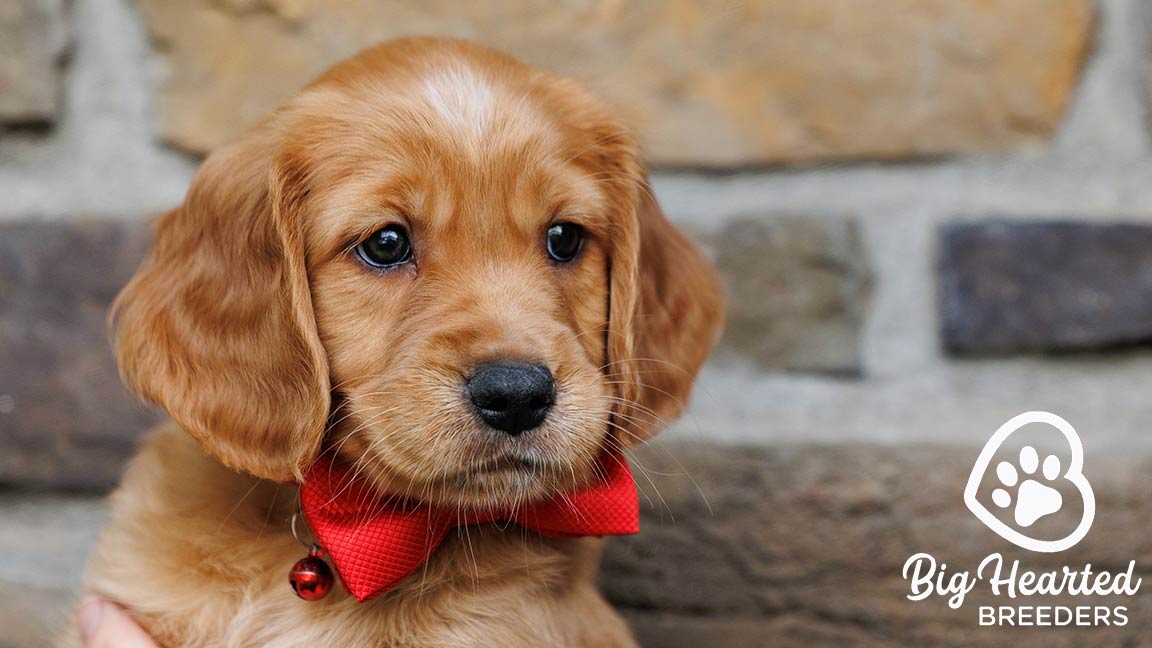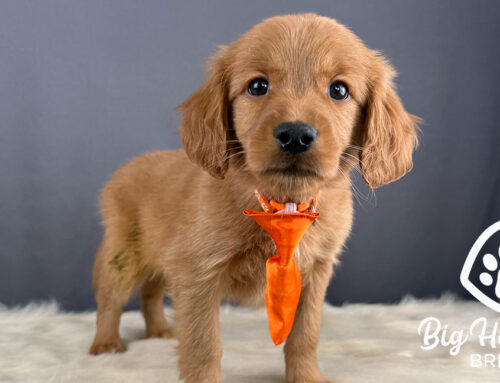How to Keep Your Dog Cool During Summer
- Understanding Your Dog’s Natural Cooling System
- 12 Proven Methods to Keep Your Dog Cool During Summer
- Recognizing Heat Stress and Emergency Response
- Special Considerations for Mini Golden Retrievers
- Long-Term Summer Preparation Strategies
- Final Thoughts: How to Keep Your Dog Cool
- Frequently Asked Questions About Keeping Dogs Cool During Summer
How to Keep Your Dog Cool During the Summer
Summer brings joy and outdoor adventures, but it also presents serious challenges for our beloved canine companions. As temperatures soar, knowing how to keep your dog cool during the summer becomes essential for every responsible pet owner. Dogs face unique physiological challenges in hot weather that can quickly escalate from discomfort to life-threatening emergencies.
At Big Hearted Breeders, we have spent years observing how different dogs respond to summer heat, particularly our Mini Golden Retrievers. Through careful health testing, ethical breeding practices, and raising puppies in loving, clean environments, we have gained invaluable insights into canine heat management. This comprehensive guide will help you protect your furry family member from summer heat dangers while ensuring they remain comfortable and healthy throughout the warmest months.
Our experience has taught us that prevention always surpasses treatment when it comes to heat-related issues. The strategies we share here come from real-world application in our breeding program, where we maintain optimal conditions for dogs of all ages. Whether you have a playful puppy or a senior dog, understanding how to keep your dog cool during the summer will enhance their quality of life and potentially save their life.
Understanding Your Dog’s Natural Cooling System
 Dogs possess fundamentally different cooling mechanisms compared to humans, making them particularly vulnerable to heat stress. While humans can sweat through pores across their entire body, dogs primarily regulate temperature through panting and limited sweating through their paw pads. This biological limitation means that dogs rely heavily on external cooling methods during hot weather.
Dogs possess fundamentally different cooling mechanisms compared to humans, making them particularly vulnerable to heat stress. While humans can sweat through pores across their entire body, dogs primarily regulate temperature through panting and limited sweating through their paw pads. This biological limitation means that dogs rely heavily on external cooling methods during hot weather.
The canine respiratory system works overtime during warm conditions. When dogs pant, they rapidly move air over their tongues and through their respiratory tract, facilitating evaporative cooling. However, this system becomes less efficient as humidity increases, because moisture in the air reduces evaporation rates. Additionally, dogs with shorter muzzles, such as bulldogs or pugs, face greater challenges due to their compressed airways.
In our breeding program, we have observed significant differences in heat tolerance among various dog types. Mini golden retrievers, with their moderate coat density and well-proportioned muzzles, generally handle summer heat better than many other breeds. Their smaller size also provides advantages, as they have a higher surface area to body mass ratio, allowing for more efficient heat dissipation. However, their beautiful double coat still requires careful management during peak summer months.
The color and thickness of a dog’s coat dramatically influence their heat absorption and retention. Darker coats absorb more solar radiation, while lighter colors reflect heat more effectively. Double-coated breeds like golden retrievers have evolved this coat structure for insulation, which works both ways. The undercoat can trap cool air close to the skin when properly maintained, but it can also trap heat if the dog becomes overheated.
Age plays a crucial role in heat tolerance as well. Puppies and senior dogs face increased risks because their temperature regulation systems are either still developing or declining in efficiency. Young puppies cannot regulate their body temperature as effectively as adult dogs, while older dogs may have underlying health conditions that compromise their cooling abilities.
12 Proven Methods to Keep Your Dog Cool During Summer
Immediate Cooling Strategies
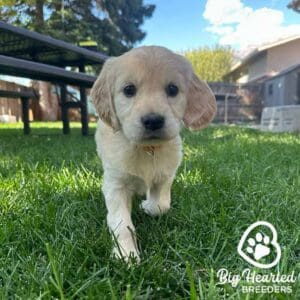
Fresh Water Access and Strategic Hydration
Maintaining constant access to fresh, cool water forms the foundation of summer dog care. We recommend placing multiple water bowls throughout your home and yard. Adding ice cubes provides additional cooling benefits, and many dogs enjoy crunching on ice as a refreshing treat. Consider investing in insulated water bowls that maintain cooler temperatures longer, especially for outdoor use.
Cooling Mats and Specialized Equipment
High-quality cooling mats offer immediate relief by absorbing and dissipating body heat. These mats work through gel technology or water circulation systems that activate when your dog lies down. Position cooling mats in your dog’s favorite resting spots, including their crate, favorite napping areas, and near air conditioning vents. Cooling vests provide mobile relief for dogs who need to be active during warmer periods, using evaporative cooling technology to maintain comfortable body temperatures.
Wet Towel Techniques and Water Applications
Dampening towels with cool water and placing them over your dog’s back, neck, and chest provides rapid cooling relief. Focus on areas where blood vessels run close to the skin surface, including the neck, armpits, and groin area. For more intensive cooling, you can gently hose your dog with cool water or encourage them to stand in shallow water. Always use cool rather than cold water to avoid shocking their system and potentially causing blood vessels to constrict.
Strategic Fan Placement and Air Circulation
Proper air circulation significantly enhances your dog’s natural cooling mechanisms. Position fans to create cross breezes throughout your home, paying special attention to areas where your dog spends the most time. Ceiling fans work exceptionally well for general air movement, while portable fans can target specific resting areas. When using fans in conjunction with wet towels or cooling mats, the evaporative effect increases dramatically.
Environmental Modifications
Shade Creation and Outdoor Protection
Creating adequate shade becomes essential for dogs who spend time outdoors. Natural shade from trees provides the best cooling effect, but you can supplement with umbrellas, tarps, or purpose-built dog shade structures. Ensure shade covers remain stable in the wind and provide enough space for your dog to move comfortably. Remember that shade moves throughout the day, so check periodically to ensure your dog maintains protection from direct sunlight.
Indoor Cooling Zone Establishment
Designate specific areas of your home as cooling zones where your dog can retreat when feeling overheated. Basements naturally stay cooler and provide excellent refuge during extreme heat. If you lack a basement, choose rooms with tile or hardwood flooring, as these surfaces remain cooler than carpeted areas. Close curtains or blinds during peak sun hours to prevent solar heat gain through windows.
Flooring Considerations and Surface Management
Different flooring materials dramatically affect your dog’s comfort level. Tile, stone, and concrete floors provide natural cooling surfaces that help dissipate body heat. If your home has primarily carpeted areas, consider placing cooling mats or damp towels on the floor to create cool spots. For outdoor areas, be mindful of hot pavement, asphalt, and metal surfaces that can burn paw pads and radiate heat upward.
Activity and Schedule Modifications
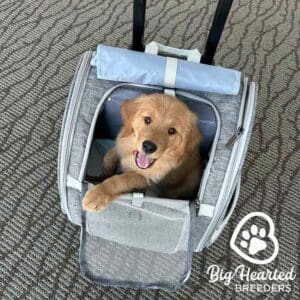
Exercise Timing and Intensity Adjustments
Modifying your dog’s exercise schedule prevents overheating while maintaining their physical and mental health. Schedule walks and active play sessions during early morning hours, typically before 8 AM, when temperatures remain cooler and pavement has not yet absorbed heat. Evening exercise sessions work well after 7 PM, once the sun begins setting and surfaces start cooling. During midday hours, limit outdoor activities to brief bathroom breaks in shaded areas.
Walk Surface Awareness and Paw Protection
Hot pavement and asphalt can reach temperatures exceeding 150 degrees Fahrenheit, causing severe burns to paw pads within seconds. Test surface temperatures by placing your hand on the ground for five seconds. If the surface feels too hot for your hand, it will burn your dog’s paws. Choose grass, dirt paths, or shaded walkways for summer walks. Protective booties provide additional safety for dogs who must walk on hot surfaces.
Swimming Opportunities and Water Play
Swimming provides excellent exercise while keeping dogs cool simultaneously. Many dogs naturally enjoy water activities, making swimming an ideal summer exercise option. Kiddie pools, sprinklers, and garden hoses offer accessible water play opportunities for dogs without access to natural swimming areas. Always supervise water activities and ensure your dog can easily exit pools or water features independently.
Rest Period Scheduling and Recovery Time
Building adequate rest periods into your dog’s daily routine prevents cumulative heat stress. After any physical activity, allow your dog time to cool down completely before engaging in additional exercise. Monitor their breathing patterns and energy levels to gauge recovery progress. Provide access to cooling resources during rest periods, including fresh water, shade, and comfortable resting surfaces.
Recognizing Heat Stress and Emergency Response

Understanding the early warning signs of heat stress can mean the difference between a minor incident and a life-threatening emergency. Dogs progress through stages of heat-related illness, beginning with mild discomfort and potentially escalating to dangerous heat stroke if left untreated.
Early signs include excessive panting that seems disproportionate to activity level, increased drooling, and restlessness or seeking cooler surfaces. As heat stress progresses, you may notice difficulty breathing, weakness or lethargy, loss of coordination, and changes in gum color from normal pink to bright red or pale. Advanced heat stroke symptoms include vomiting, diarrhea, collapse, and loss of consciousness.
We experienced a concerning heat stress incident several years ago with one of our puppies during an unexpectedly warm spring day. The puppy had been playing outside for what seemed like a normal amount of time, but the combination of excitement, physical activity, and rising temperatures created a perfect storm. We noticed the puppy seeking shade repeatedly and panting more than usual. Recognizing these early warning signs, we immediately brought the puppy inside, provided cool water, and used damp towels to help lower their body temperature. The puppy recovered quickly with prompt intervention, but this experience reinforced the importance of constant vigilance during warm weather.
Emergency Cooling Protocol
If you suspect heat stress, act immediately. Move your dog to a cool, shaded area or an air-conditioned space. Offer small amounts of cool water, but do not force drinking if your dog seems disoriented. Apply cool, wet towels to the neck, armpits, and groin areas where major blood vessels run close to the surface. Use fans to increase air circulation around your dog. Monitor their temperature if possible, aiming to gradually reduce it to normal levels around 101 to 102.5 degrees Fahrenheit.
When to Contact Your Veterinarian
Contact your veterinarian immediately if your dog shows signs of advanced heat stress, including vomiting, diarrhea, difficulty breathing, or loss of consciousness. Even if your dog seems to recover from mild heat stress, consider calling your vet for guidance, as internal complications can develop hours after the initial incident. Heat stroke can cause organ damage that may not be immediately apparent, making professional evaluation crucial for your dog’s long-term health.
Special Considerations for Mini Golden Retrievers
 Mini golden retrievers possess unique characteristics that influence their summer care requirements. Their smaller stature provides natural advantages in heat management, as their reduced body mass allows for more efficient temperature regulation compared to standard-sized golden retrievers. However, their beautiful double coat still requires thoughtful management during summer months.
Mini golden retrievers possess unique characteristics that influence their summer care requirements. Their smaller stature provides natural advantages in heat management, as their reduced body mass allows for more efficient temperature regulation compared to standard-sized golden retrievers. However, their beautiful double coat still requires thoughtful management during summer months.
In our breeding program, we have observed that mini golden retrievers typically handle summer heat more effectively than their larger counterparts, but they still benefit from proactive cooling strategies. Their moderate coat density provides some insulation benefits when properly maintained, but regular grooming becomes essential during warmer months. We recommend professional grooming every six to eight weeks during summer, focusing on thinning the undercoat while maintaining the protective outer layer.
The health testing we conduct on all our breeding dogs provides valuable insights into each dog’s overall health status, which directly impacts their heat tolerance. Dogs with excellent cardiovascular health, clear airways, and optimal body weight demonstrate superior heat management capabilities. Our commitment to health guarantees reflects our confidence in the genetic soundness of our dogs, including their ability to thrive in various environmental conditions.
We have noticed that our mini golden retrievers often seek out cool surfaces instinctively, gravitating toward tile floors, shaded grass areas, and even cool dirt patches in the yard. This natural behavior suggests an inherent understanding of temperature regulation that owners can support by providing appropriate cooling options throughout their living environment.
Long-Term Summer Preparation Strategies
Successful summer dog care extends beyond daily management to include seasonal preparation and environmental modifications. Begin preparing for summer weather several weeks before temperatures rise by gradually acclimating your dog to warmer conditions and implementing cooling infrastructure in your home and yard.
Seasonal Grooming and Coat Management
Schedule professional grooming appointments before summer heat arrives to ensure your dog’s coat stays cool. Discuss with your groomer the best approach for your dog’s specific coat type, as some breeds benefit from trimming while others require only undercoat removal. Regular brushing at home helps remove loose undercoat and improves air circulation through the remaining fur.
Health Checkups and Preventive Care
Annual veterinary checkups become critical before the summer months, as underlying health conditions can significantly impact heat tolerance. Ensure your dog maintains optimal body weight, as excess weight increases the risk of heat stress. Address any respiratory issues, heart conditions, or other health concerns that might compromise your dog’s cooling abilities.
Home and Yard Modifications
Consider permanent improvements to your living environment that enhance summer comfort for your dog. Install additional shade structures in your yard, improve ventilation in indoor spaces, and create dedicated cooling zones with appropriate flooring and air circulation. These investments provide long-term benefits for your dog’s comfort and safety.
Emergency Preparedness
Assemble a summer emergency kit that includes cooling supplies, a reliable thermometer, your veterinarian’s contact information, and transportation plans for emergencies. Keep cooling mats, towels, and portable fans easily accessible during warm weather. Know the location of the nearest emergency veterinary clinic in case immediate professional care becomes necessary.
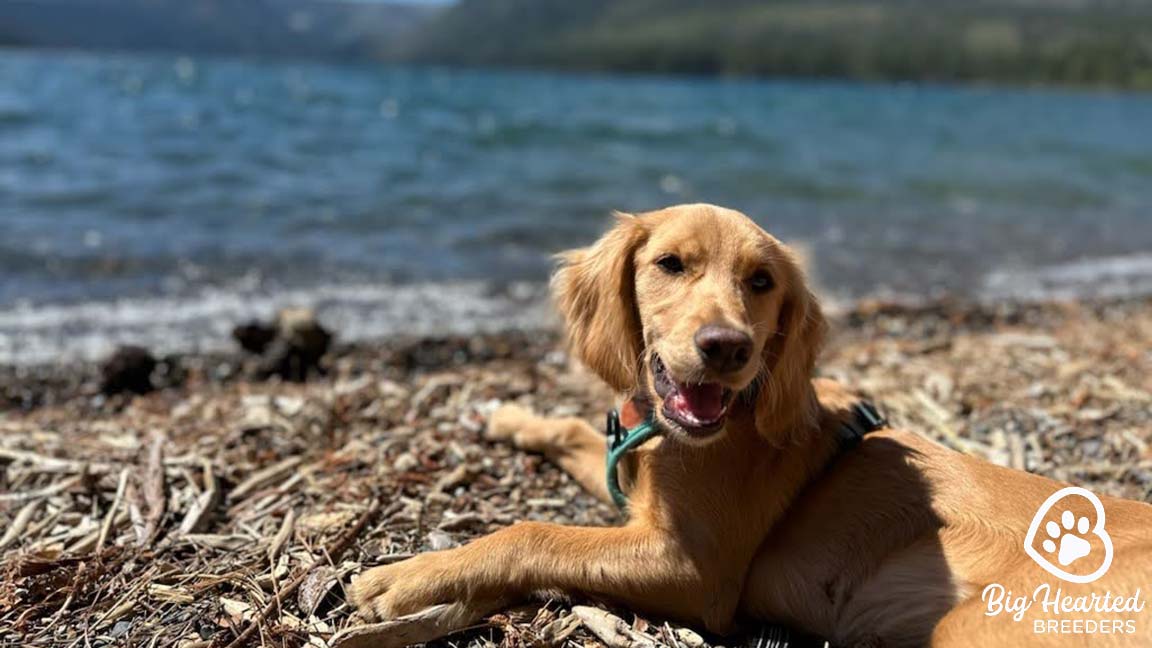
Final Thoughts: How to Keep Your Dog Cool
Learning how to keep your dog cool during the summer represents a fundamental aspect of responsible pet ownership that can significantly impact your dog’s health, comfort, and quality of life. The strategies outlined in this guide provide comprehensive protection against heat-related dangers while maintaining your dog’s physical and mental well-being throughout the warmest months of the year.
At Big Hearted Breeders, our commitment to ethical breeding practices, comprehensive health testing, and raising puppies in loving environments extends to educating families about proper care throughout their dog’s lifetime. The knowledge we have gained through years of experience with Mini Golden Retrievers and other breeds reinforces the importance of proactive heat management and emergency preparedness.
Remember that prevention always surpasses treatment when dealing with heat-related issues. By implementing these proven cooling strategies, closely monitoring your dog’s condition, and preparing for emergencies, you provide your beloved companion with the best possible protection against summer heat dangers. Your dedication to understanding how to keep your dog cool during the summer demonstrates the loving, responsible approach that creates lasting bonds between families and their canine companions.
Frequently Asked Questions About Keeping Dogs Cool During Summer
How often should I give my dog water during hot weather?
Dogs should have constant access to fresh, cool water during summer months. Refill water bowls at least twice daily, and more frequently during extreme heat. Monitor your dog’s water intake, as increased consumption is normal during hot weather. If your dog suddenly stops drinking or drinks excessively, contact your veterinarian immediately.
Can I shave my dog’s coat to help them stay cooler?
Generally, you should not completely shave double-coated breeds like golden retrievers. Their coat actually provides insulation that can help regulate temperature when properly maintained. Instead, focus on:
- Regular brushing to remove loose undercoat
- Professional grooming to thin the undercoat
- Keeping the protective outer layer intact
For single-coated breeds, light trimming may help, but consult your groomer or veterinarian first.
What temperature is too hot for dogs to be outside?
Most dogs should not spend extended time outdoors when temperatures exceed 85°F (29°C), especially with high humidity. However, this varies by breed, age, and health status. Mini golden retrievers may tolerate slightly higher temperatures than larger breeds, but always prioritize safety. Use the “five second rule” for pavement: if you cannot keep your hand on the ground for five seconds, it’s too hot for your dog’s paws.
How do I know if my dog is overheating?
Watch for these warning signs of overheating:
- Excessive panting or difficulty breathing
- Drooling more than usual
- Lethargy or weakness
- Vomiting or diarrhea
- Loss of coordination
- Bright red or pale gums
If you notice any of these symptoms, immediately move your dog to a cool area and begin cooling measures.
Can I use ice or very cold water to cool my overheated dog?
No, avoid using ice or extremely cold water on an overheated dog. This can cause blood vessels to constrict, actually trapping heat inside the body and potentially causing shock. Instead, use cool (not cold) water and apply it gradually to help lower body temperature safely.
How long should I wait after exercise before letting my dog go outside again?
Allow your dog to cool down completely before additional outdoor activity. This typically takes 15 to 30 minutes, depending on the intensity of exercise and ambient temperature. Monitor your dog’s breathing and energy levels to determine when they have fully recovered.

